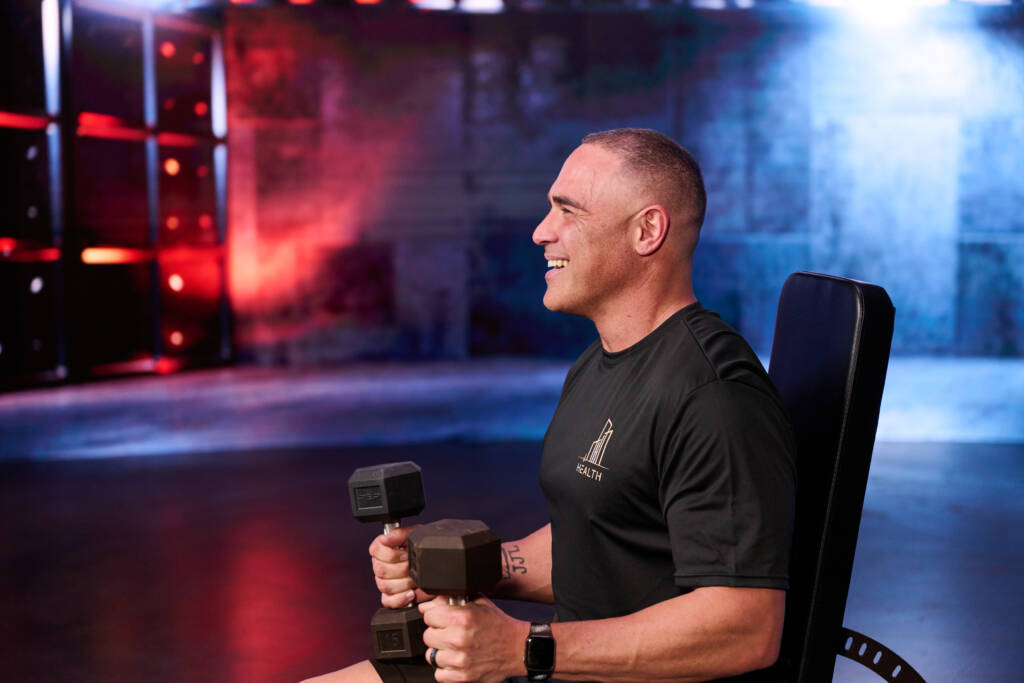Digital DNA

The H Health - Our DNA
You wake up with stiff joints, an aching back, a nagging injury that never seems to fully heal, or poor recovery from an important game. Maybe you’ve been told to “just rest,” or you’ve tried generic workout plans that weren’t built for your body.
Maybe you’re stuck on a waitlist, hoping to see someone who actually knows what they’re talking about. You scroll through endless fitness advice, unsure what’s actually safe or effective for you. Meanwhile, the experts who truly understand movement—the ones who can help you heal, get stronger, perform at your peak, prevent injuries, and move without pain—are locked behind high fees, insurance red tape, or expensive in-person sessions.
Your body is a system—an interconnected grid of movement, strength, recovery, and resilience. But without the right knowledge, it’s easy to feel lost in the process. Now, you don’t have to guess.
With thousands of expert-led, science-backed videos, you’ll learn how to train smarter, recover faster, and optimize your performance—whenever and wherever you need it. No waitlists. No overpriced sessions. No one-size-fits-all routines. Just real guidance, real results.
Here, you don’t need a referral. You don’t need a perfect body. You don’t need to be an athlete—or maybe you are, and you’re looking for an edge. You just need a desire to feel better, move better, and take control of your health. No waiting rooms. No overpriced sessions. No one-size-fits-all routines. Just a smarter, more affordable way to improve your body. Because movement is for everyone, and taking care of your body shouldn’t be a privilege.
And now, it isn’t.

Recovery
i. Prioritizing recovery allows muscles to repair and grow stronger, improving performance in future workouts by increasing blood circulation to deliver nutrients for muscle repair.
ii. Cold water immersion (such as ice baths) and contrast therapy (alternating hot and cold treatments) have been shown to reduce muscle inflammation and accelerate recovery after intense exercise.
iii. Focused recovery activities, including mindfulness and relaxation techniques, enhance mental resilience, boosting focus and maintaining motivation during training.
iv. Adequate recovery reduces overuse injuries by allowing the body to heal and adapt to training loads, ensuring long-term health and consistent performance.
v. Recovery activities improve sleep patterns, promoting muscle recovery and physical performance while enhancing cognitive function.
vi. Recovery practices help balance stress hormones, preventing the negative effects of chronic stress on the body and supporting overall well-being.
Nutrition
i. Adequate nutrition provides essential vitamins and minerals, promoting stable energy levels, strong bones and teeth, and improved mental health in Children.
ii. Eating a Mediterranean diet, rich in healthy fats, fish, and antioxidants, has been shown to enhance cognitive function, improve memory, and boost mental resilience.
iii. A balanced diet helps maintain a healthy weight and reduces the risk of developing chronic conditions such as heart disease, stroke, diabetes, and certain types of cancer.
iv. Good nutrition strengthens the immune system, enhancing the body’s ability to fight infections and illnesses.
v. In older adults, proper nutrition supports energy levels and protects against age-related illnesses like heart disease, cancer, and diabetes.
vi. Balanced nutrition contributes to improved mental health, making individuals think clearly and be more alert, which is crucial for overall well-being.
Mindfulness
i. Mindfulness techniques help individuals of all ages manage stress by promoting relaxation and reducing anxiety.
ii. Regular mindfulness practice enhances emotional resilience, aiding in better mood management and reducing symptoms of Depression.
iii. Mindfulness has been linked to improved attention span and memory retention, benefiting cognitive health across the lifespan.
iv. Engaging in mindfulness practices can lead to improved sleep patterns, contributing to overall health and well-being.
v. Mindfulness fosters greater self-awareness, allowing individuals to understand and manage their thoughts and emotions more effectively.
vi. Mindfulness practices have been associated with lower blood pressure and improved immune function, supporting overall physical health.
Breathing
i. Engaging in breathwork activates the body’s relaxation response, leading to decreased stress and anxiety levels.
ii. Breathwork enhances oxygen efficiency, reducing stress-related inflammation, which may support immune Resilience.
iii. Practicing controlled breathing exercises can help lower blood pressure and improve overall circulation.
iv. Breathwork improves cognitive function, leading to better concentration and mental clarity.
v. Incorporating breathwork into your routine can help you fall asleep faster and improve sleep quality.
vi. Breathwork activates the parasympathetic nervous system, promoting relaxation and supporting healthy digestion.
Sleep
i. Quality sleep enhances cognitive abilities, including memory, problem-solving skills, and concentration. It also plays a crucial role in emotional regulation and mental health.
ii. Consistent, restful sleep boosts the body’s ability to fight off infections and illnesses. Sleep deprivation can weaken immune responses, making individuals more susceptible to diseases.
iii. Adequate sleep helps maintain a healthy weight by balancing hormones that control appetite and metabolism. Lack of sleep can disrupt these hormones, leading to increased hunger and potential weight gain.
iv. Quality sleep improves athletic performance by aiding muscle recovery, increasing reaction times, and reducing the risk of injury. It also supports cardiovascular health, contributing to overall physical fitness.
v. Sufficient sleep is linked to better mood regulation and a lower risk of mental health disorders such as depression and anxiety. It contributes to emotional stability and resilience.
vi. Consistently getting adequate sleep is associated with a longer lifespan and a reduced risk of chronic diseases, including heart disease and diabetes. Prioritizing sleep can lead to a healthier, longer life.
Mobility
i. Regular physical activity in older adults is associated with better mobility and physical function.
ii. Engaging in physical activities can reduce the risk of falls and related injuries, contributing to sustained Independence.
iii. Individuals who maintain higher levels of physical activity during midlife (ages 20–64) exhibit better mobility and muscle strength in older Age.
iv. Physically active middle-aged adults have a lower risk of developing functional limitations as they age.
v. Studies confirm at least 52 hours of exercise over time is associated with cognitive improvements in both healthy older adults and those with mild impairment.
vi. Engaging in mobility exercises can reduce symptoms of depression and anxiety across all age groups.
vii. New research confirms that walking more can extend lifespan, with the strongest benefits seen in individuals who transition from a sedentary to an active lifestyle.
viii. Daily physical activity reduces the risk of chronic diseases and mortality, serving as a primary prevention Strategy.
Flexibility
i. Stretching and mobility exercises enhance joint function, prevent stiffness, and improve balance, reducing fall risk.
ii. For middle-aged individuals, stretching and flexibility exercises can reduce chronic back and joint pain by up to 25%, improving overall physical function and quality of life.
iii. Regular flexibility exercises improve posture and balance, reducing the risk of falls and supporting proper body alignment.
iv. Flexibility exercises can increase muscle performance in men, with studies showing a 20% improvement in athletic performance (e.g., speed, strength) after 8 weeks of consistent stretching.
v. Regular flexibility exercises improve circulation and may contribute to better heart health by reducing arterial stiffness.
vi. Flexibility exercises can reduce stress by lowering cortisol levels in middle-aged adults. A study revealed that 30 minutes of stretching can reduce cortisol by up to 10%, leading to improved mental well-being.
Strength
i. Strength training helps counteract age-related muscle loss (sarcopenia), improving strength, balance, and reducing Fall Risk.
ii. Regular strength training enhances muscle mass, supports joint health, and helps prevent chronic conditions like arthritis and heart disease.
iii. Women who strength train at least twice a week reduce heart disease risk, maintains bone density, and increases longevity.
iv. Strength training enhances metabolism, increases lean muscle mass, and improves long-term physical performance in men.
v. Strength training reduces the risk of obesity, diabetes, heart disease, and depression while improving overall Health.
vi. Strength training enhances cognitive function and may slow age-related mental decline.
Endurance
i. Engaging in endurance activities strengthens the heart, improving its efficiency and reducing the risk of heart disease.
ii. Regular endurance exercise boosts lung capacity and efficiency, facilitating better oxygen exchange and overall respiratory health.
iii. Consistent endurance training enhances muscle stamina, enabling individuals to perform daily tasks with less fatigue.
iv. Endurance exercises burn calories effectively, aiding in weight loss and maintenance by increasing metabolism.
v. Engaging in endurance activities can reduce symptoms of depression and anxiety, promoting overall mental well-being.
vi. Engaging in regular endurance exercise is linked to a longer lifespan and a lower risk of chronic diseases such as cardiovascular disease, diabetes, and some cancers.
Core Stability
i. A strong core enhances balance and steadiness, which is crucial for daily activities and sports performance.
ii. Core stability helps protect the back and other muscles from injury by providing support during movement.
iii. Strengthening core muscles contributes to better posture, reducing strain on the spine and muscles.
iv. A stable core is vital for performing everyday tasks, such as lifting, bending, and twisting, with proper form and reduced risk of injury.
v. Core stability is essential for athletes, as it enhances performance in various sports by providing a solid foundation for movement.
vi. Weak core muscles contribute to lower back pain, hip misalignment, and poor spinal support, all of which are exacerbated by prolonged sitting.
Balance
i. Regular balance exercises improve stability, reducing the risk of falls, especially in older adults.
ii. Strengthening core and lower body muscles through balance training promotes better posture and alignment.
iii. Balance exercises enhance coordination between the brain and muscles, leading to more efficient movement patterns.
iv. Incorporating balance training into rehabilitation programs aids in recovery from injuries by restoring functional movement.
v. Balance training increases postural control, stability, and proprioception, all of which are critical for athletic movements and injury prevention.
vi. Maintaining balance through regular training helps individuals perform daily activities safely, supporting independence and quality of life.
Power
i. Power training improves the ability to generate force rapidly, benefiting athletes across various sports.
ii. Incorporating power exercises into your routine can lead to increased muscle mass and strength, contributing to overall physical health.
iii. Fast-twitch muscle activation through power exercises improves neuromuscular coordination, making daily movements more efficient.
iv. Engaging in power exercises can stimulate bone growth and increase bone density, reducing the risk of osteoporosis.
v. Power training improves neuromuscular function, leading to better balance and coordination, which is crucial for preventing falls, especially in older adults.
vi. Incorporating power exercises into your fitness routine can increase your resting metabolic rate, aiding in weight management and fat loss.
Speed/Agility
i. Speed and agility training enhances an athlete’s ability to perform complex movements quickly and efficiently, leading to faster starts and quicker transitions during games.
ii. Neuromuscular efficiency enhances motor unit recruitment, increasing force production and optimizing movement precision.
iii. By improving speed and agility, athletes can reduce their reaction time, which is crucial in sports that require frequent changes in direction, such as soccer, tennis, and basketball.
iv. Speed and agility training improves balance, coordination, and control, reducing the risk of falls and missteps that can lead to injuries.
v. Research highlights that speed and agility exercises enhance neuromuscular control, proprioception, and coordination, which are crucial for maintaining movement efficiency in everyday life.
vi. Engaging in speed and agility training can help prevent injuries by promoting proper biomechanics, enhancing flexibility, and strengthening muscles, reducing the risk of sports-related injuries.
Fall Care
i. Approximately one in four adults aged 65 and older reports falling each year, equating to over 14 million falls annually in the United States.
ii. In 2021, falls caused over 38,000 deaths among older adults, making it the leading cause of injury death in this age group.
iii. In 2022, over 3.5 million older adults aged 65 and older were treated in emergency departments for fall-related.
iv. Many falls are preventable through measures such as regular exercise to improve balance and strength, medication management, and home safety modifications.
v. The direct medical costs for fall injuries in older adults are substantial, with estimates reaching billions of dollars annually in the United States.
vi. Falls can lead to a loss of independence, as older adults may require assistance with daily activities following a fall.
Prenatal Physical Activity
i. Regular exercise can alleviate common pregnancy issues such as back pain and constipation.
ii. Physical activity during pregnancy has been linked to improved mood and better sleep quality.
iii. Engaging in regular exercise may lower the risk of gestational diabetes, preeclampsia, and cesarean delivery.
iv. Maintaining an active lifestyle helps manage weight gain within recommended guidelines during pregnancy.
v. Physical activity helps regulate maternal heart rate, improves oxygen supply to the fetus, and supports fetal cardiovascular development.
vi. Staying active during pregnancy can lead to a quicker recovery after childbirth.
Postnatal
i. Moderate-intensity exercise significantly lowers postpartum depression symptoms and improves overall psychological well-being.
ii. Combining physical activity with healthy eating habits can facilitate weight loss after delivery.
iii. Moderate-intensity physical activity supports heart and lung health during the postpartum period.
iv. Engaging in regular physical activity can enhance sleep quality, which is crucial for new mothers.
v. Postnatal exercises help restore muscle strength and joint stability, particularly in the pelvic floor and abdominal Areas.
vi. Engaging in gentle exercises, such as walking, can be initiated within a few days after childbirth, aiding in the Recovery process
Injury Prevention
i. High school athletes account for approximately 2 million various injuries each year, leading to 500,000 doctor visits and 30,000 hospitalizations.
ii. More than one out of four older people falls each year, but less than half tell their doctor. Falling once doubles your chances of falling again.
iii. Injuries result in significant economic costs, including medical expenses, lost productivity, and long-term care costs, underscoring the importance of prevention strategies.
iv. Studies indicate that women are 2.2 times more likely to suffer anterior cruciate ligament (ACL) injuries than men, emphasizing the need for targeted prevention programs.
v. Repetitive stress injuries (RSIs) remain prevalent in workplaces, particularly affecting office workers, factory employees, and athletes. Proper ergonomics and movement strategies are key to prevention.
vi. In the U.S., about 30 million children and teens participate in organized sports, with more than 3.5 million injuries occurring annually, underscoring the importance of injury prevention in youth sports.
Cardiovascular Fitness
i. Aerobic exercise improves heart function by increasing stroke volume (amount of blood pumped per beat) and reducing resting heart rate, lowering cardiovascular stress.
2. Engaging in consistent cardio activity can help reduce high blood pressure, decreasing the risk of heart disease and stroke.
iii. Aerobic exercise aids in controlling insulin levels and lowering blood sugar, which is beneficial for managing and preventing type 2 diabetes.
iv. Cardiovascular workouts improve lung capacity and efficiency, leading to better oxygen delivery throughout the body.
v. Regular cardio exercise has been linked to reduced symptoms of depression and anxiety, contributing to overall mental well-being.
vi. Engaging in cardiovascular activities helps burn calories, aiding in weight loss and maintenance.
testimonials
What Our Members Say
You wont be disappointed… keep them on speed dial! The H Health is the best!
Ike S
As a freshman, my son suffered a broken leg while playing a high school soccer game. While he was fortunate relative to not requiring surgery (i.e., pins or plates), he was in need of significant rehabilitation to have any chance of playing soccer at a competitive level again. In my opinion, the greatest tools and resources at The H Health is the knowledge/expertise and dedication of the staff in working with clients. My son was able to not only recover during his rehabilitation but he was able to gain strength and speed that he would never had realized without The H Health staff.
Anonymous
In order to stay competitive, I needed to take care of my body. Tennis is hard on the body and The H Health helped me stay fit. They helped address my minor and major issues on a consistent basis. My recovery times have been significantly reduced since using The H Health. When I had nagging hamstring injuries, The H Health came up with a program to help me strengthen my muscles in order to stay competitive.
Abhishek Thorat
We have always known how important physical activity and exercise was but it became more obvious as we have gotten older that we needed some direction and guidance as we headed Into our 50’s. We knew that in order to get the most out of our physical fitness, we needed sound guidance and direction and most importantly, the proper tools to help us with avoiding injuries and staying healthy and consistent. I have had issues with my knees for a few years. I had tried many different methods and wasn’t experiencing much relief, but The H Health has provided me so many tools to implement into my fitness routine that my knees are amazingly better!
David and Kris Lackman
When I first worked with The H Health, my wrist was in really bad shape and I wasn’t able to compete or practice tennis at all. They helped me get back to 100% and back on the court doing what I love. I would definitely recommend working with The H Health. They were instrumental in my wrist recovery and return to the tennis court. They are extremely knowledgeable and helpful every step of the way.
Quinn Gleason
Every experience is empowering. They helped me continue to play soccer at a high level. The H Health services improved my body wellness and helps me strive in any activity.
Russell T
I wanted to take the next step in my athletic career, I wanted to be stronger, faster, more mobile, and overall just a better athlete. They have helped me tremendously not just in my sport but in daily life as well. My body has never felt this good or this strong.
Xavier C
Start Optimizing Today!
Ready to commit to moving better, performing stronger, and recovering smarter? Wherever you are in your journey, The H Health is here to elevate, support, and empower your next move.


